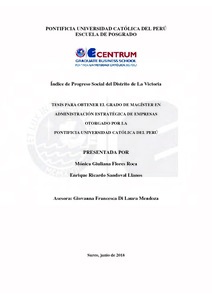| dc.contributor.advisor | Di Laura Mendoza, Giovanna Francesca | |
| dc.contributor.author | Flores Roca, Mónica Giuliana | es_ES |
| dc.contributor.author | Sandoval Llanos, Enrique Ricardo | es_ES |
| dc.date.accessioned | 2018-09-14T16:04:06Z | |
| dc.date.available | 2018-09-14T16:04:06Z | |
| dc.date.created | 2018 | |
| dc.date.issued | 2018-09-14 | |
| dc.identifier.uri | http://hdl.handle.net/20.500.12404/12646 | |
| dc.description.abstract | El Índice de Progreso Social (IPS) mide el nivel de desarrollo social de una
determinada población con el propósito de mejorar el nivel y calidad de vida de sus
habitantes. El objetivo principal de la presente investigación consiste en elaborar un índice
que compare las tres dimensiones del progreso social para el distrito de La Victoria en el
2017 y que permita medir y determinar el nivel de desarrollo del distrito. La metodología de
la investigación siguió las pautas de la investigación exploratoria. Por lo tanto, se distingue
como cuantitativa, no experimental y transaccional con alcance descriptivo. Asimismo, la
elaboración del IPS se construyó bajo la metodología del Social Progress Imperative. Para
ello, se utilizó un instrumento (cuestionario) con el objetivo de recolectar los datos obtenidos
de las encuestas realizadas a los jefes de hogar de cada familia del distrito de una muestra
determinada para proceder con el levantamiento de información y análisis estadístico. Los
resultados se presentaron de acuerdo con las dimensiones, los componentes y cada una de las
ocho zonas del distrito que se determinaron para la presente investigación. Se ha demostrado
que las principales fortalezas del distrito se encuentran en la dimensión de Necesidades
Humanas Básicas, principalmente en los componentes de agua potable y saneamiento, y
vivienda y servicios públicos; en tanto que en la dimensión de Oportunidades, en tolerancia e
inclusión. Por otro lado, sus debilidades también se encuentran en la dimensión de Necesidades
Humanas Básicas, específicamente en el componente de seguridad personal; en la dimensión
de Oportunidades, en acceso a educación superior; y en la dimensión de Fundamentos del
Bienestar, en sostenibilidad ambiental. De manera general, presenta un nivel de progreso
social calificado medio bajo, dentro de las cuales la zona C2 tiene una calificación de bajo. | es_ES |
| dc.description.abstract | The Social Progress Index measures the level of social development of a given
population with the purpose of improving the level and quality of life of the people who live
in it. The main objective of this research is to develop the Index that compares the three
pillars of social progress for the District of La Victoria 2017 and that allows to measure and
determine the level and / or state of the development progress of the district. The
methodology of the research developed was according to the guidelines of the exploratory
research, and, therefore, is quantitative, not experimental transactional with descriptive scope.
Likewise, the preparation of the Social Progress Index (IPS) was developed using the Social
Progress Imperative of Social Progress Index methodology. An instrument was used for this
purpose, which was a questionnaire with the objective of collecting data obtained from the
surveys carried out on the household heads of each family in the La Victoria district of a
given sample in order to proceed with the gathering of information and making a statistical
analysis. The results were shown by dimensions, by components and by each of the eight
zones of the district that were determined for the present investigation, identifying that the
main strengths of the district are in the dimensions of Basic Human Needs mainly in the
components of drinking water and sanitation, housing and public services, as well as
tolerance and inclusion in the Opportunities dimension. On the other hand, its weaknesses are
in the Human Basic Needs dimension, specifically on the personal security compounds.
Furthermore, in the Opportunities dimension, in superior education access, as well as in
Fundamentals of Wellbeing, principally in environmental sustainability. To sum up, its
presents an medium low level of qualified social progress, within those one zones (C2) have a
low rating. | es_ES |
| dc.language.iso | spa | es_ES |
| dc.publisher | Pontificia Universidad Católica del Perú | es_ES |
| dc.rights | info:eu-repo/semantics/openAccess | es_ES |
| dc.rights.uri | http://creativecommons.org/licenses/by-nc-nd/2.5/pe/ | * |
| dc.subject | Indicadores sociales--Perú--La Victoria (Lima : Distrito) | es_ES |
| dc.subject | Indicadores económicos--Perú--La Victoria (Lima : Distrito) | es_ES |
| dc.subject | Investigación cuantitativa | es_ES |
| dc.title | Índice de progreso social del distrito de La Victoria | es_ES |
| dc.type | info:eu-repo/semantics/masterThesis | es_ES |
| thesis.degree.name | Maestro en Administración Estratégica de Empresas | es_ES |
| thesis.degree.level | Maestría | es_ES |
| thesis.degree.grantor | Pontificia Universidad Católica del Perú. CENTRUM | es_ES |
| thesis.degree.discipline | Administración Estratégica de Empresas | es_ES |
| renati.discipline | 413307 | es_ES |
| renati.level | https://purl.org/pe-repo/renati/level#maestro | es_ES |
| renati.type | https://purl.org/pe-repo/renati/type#tesis | es_ES |
| dc.publisher.country | PE | es_ES |
| dc.subject.ocde | https://purl.org/pe-repo/ocde/ford#5.02.04 | es_ES |






